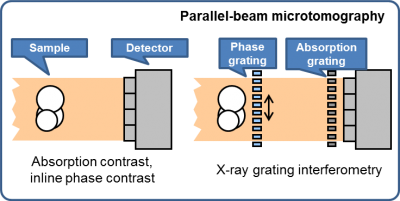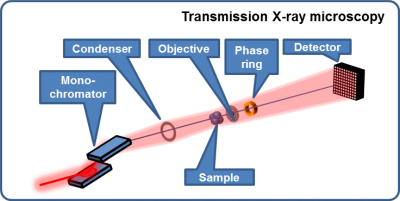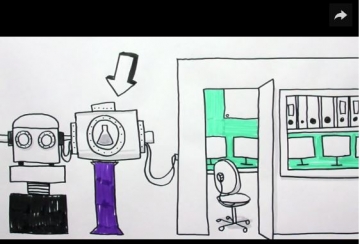
The beamline ANATOMIX (Advanced Nanotomography and Imaging with coherent X rays) works at photon energies between 5 and 50 keV. It is dedicated to full-field radiography and tomography in absorption and phase contrast, with pixel sizes from 30 nm to 10 µm.

ANATOMIX is now open to users. Contact us for details!
Construction and operation of the beamline are largely funded by the French State through the project NanoimagesX in the EQUIPEX program within the framework "Investissements d'avenir" of the French National Research Agency (ANR).
About ANATOMIX
 ANATOMIX is a beamline for X-ray tomography on the micro- and nanoscale, in absorption and phase contrast. It operates in the energy range from 5 keV upward and allows its users to obtain two- and three-dimensional radiographic images of bulk volume samples of macroscopic size (up to several cm thickness). For smaller samples, a spatial resolution down to 100 nm (30 nm pixel size) will be available. Real-time studies will be possible at speeds of up to one microtomography scan per second.
ANATOMIX is a beamline for X-ray tomography on the micro- and nanoscale, in absorption and phase contrast. It operates in the energy range from 5 keV upward and allows its users to obtain two- and three-dimensional radiographic images of bulk volume samples of macroscopic size (up to several cm thickness). For smaller samples, a spatial resolution down to 100 nm (30 nm pixel size) will be available. Real-time studies will be possible at speeds of up to one microtomography scan per second.
A sample interface designed to be as flexible as possible will enable in situ and/or in operando studies under conditions similar to the natural or working environment of the samples (temperature, humidity, mechanical load, transport processes). Biological samples can be measured without dehydration and, in many cases, without chemical fixation.
Experimental techniques on ANATOMIX
Two classes of radiographic methods will be available: parallel-beam microimaging and transmission X-ray microscopy.
| Examples: Parallel-beam microtomography | |
|---|---|
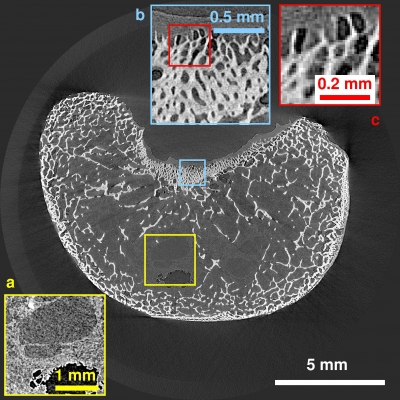 [+] [+] |
Microtomography with a wide beam: Axial tomographic slice of a chicken tibia. Taken with a white X-ray beam of peak energy 20 keV, pixel size 9.3 µm. Details: (a) soft tissue; (b,c) trabecular bone. 1000 projections, exposure time per projection 0.06 s. From [1]. |
 [+] [+] |
High-resolution phase-contrast microtomography: Axial tomographic slice of a piece of stem from a hemp plant. White beam, peak energy 10 keV, pixel size 0.65 µm, detector–sample distance 12 mm. 1500 projections, scan duration 5 minutes. Sample: J. Beaugrand, INRA, Nantes. From [1]. |
| [1] T. Weitkamp et al., "Progress in microtomography at the ANATOMIX beamline of Synchrotron Soleil", Microscopy and Microanalysis vol. 24 suppl. 2 (2018) 244–245, doi:10.1017/S1431927618013570. | |
| Examples: Transmission X-ray microscopy | |
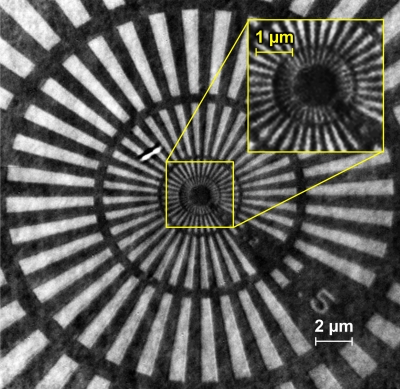 [+] [+] |
A preliminary TXM resolution test. Detail of one of the first TXM test micrographs taken on ANATOMIX, showing a reference chart with smallest widths of lines and spaces of 50 nm (center of inset). Image recorded using a "pink beam", i.e., a white beam from which one undulator harmonic (10 keV) is singled out by combination of attenuation filters and total external reflection on the beamline mirror. From [2]. |
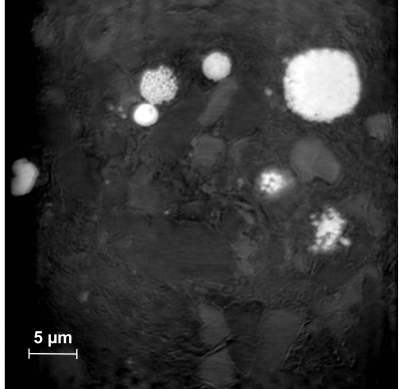 [+] [+] |
One of the first TXM tomography images from ANATOMIX: Sagittal slice of local tomography on a shale-rock sample with pyrite inclusions (light gray). Data taken with a pink undulator beam, central photon energy 10 keV. The effective pixel size was 49 nm; the resolution is estimated to 250 nm. The projection images were not realigned prior to tomographic reconstruction. The sample had a diameter of 160 µm. Sample courtesy of "Multiscale Materials Science for Energy and Environment" (MSE²), a joint laboratory of the French National Center for Scientific Research (CNRS), the Massachusetts Institute of Technology (MIT) and Aix-Marseille University (AMU). From [2]. |
| [2] M. Scheel et al., "Toward hard X-ray transmission microscopy at the ANATOMIX beamline of Synchrotron Soleil", Microscopy and Microanalysis vol. 24 suppl. 2 (2018) 246–247, doi:10.1017/10.1017/S1431927618013582. | |
See also
- the tab "Technical information" on the left,
- The tomography beamline ANATOMIX at Synchrotron SOLEIL, a paper published in the Journal of Physics: Conference Series (2017, volume 849, article no. 012037, doi:10.1088/1742-6596/849/1/012037).
Contacts
Want to perform an experiment on ANATOMIX? Or find out whether the beamline might be suited for your project? The ANATOMIX beamline scientists are happy to answer your questions and give advice:
| Timm Weitkamp | +33 (0)1 69 35 81 37 timm.weitkamp@synchrotron-soleil.fr |
| Mario Scheel | +33 (0)1 69 35 96 31 mario.scheel@synchrotron-soleil.fr |
| Jonathan Perrin | +33 (0)1 69 35 94 99 jonathan.perrin@synchrotron-soleil.fr |
Telephone numbers of beamline rooms
| Beamline control room near optics hutches | +33 (0)1 69 35 97 31 |
| Beamline control room experiments | |
| Experiment hutch EH3 | +33 (0)1 69 35 97 82 |
| Experiment hutch EH4 | |
| Meeting and data analysis room | +33 (0)1 69 35 97 71 |
| Preparation laboratory | |
| Workshop | +33 (0)1 69 35 99 80 |
Team
Employment
Click here to access the SOLEIL employment web page
Technical data
Parallel-beam full-field microtomography
- Absorption contrast (operational),
- Inline phase contrast (operational),
- X-ray grating interferometry (planned)
Full-field zone-plate microscopy (under test)
- Absorption contrast,
- Zernike phase contrast
Between 5 and 50 keV (white beam)
Up to approximately 25 keV (monochromatic)
From 0.04 mm × 0.04 mm to 40 mm (H) × 15 mm (V)
Filtered white beam
Double crystal monochromator Si-111: ΔE/E = 10-4
Double multilayer monochromator: ΔE/E = 10-2 (planned 2019)
U18 cryogenic in-vacuum undulator
Entrance aperture: Diaphragm 2.5 mm × 2.0 mm (H×V), 22.7 m from source.
Horizontal "coherence" slit, 23.2 m from source.
Primary slits, 26 m from source.
Double mirror (removable), horizontal reflection, horizontally focusing, f=3.5 m, 35.5 m from source.
Refractive lenses for collimation (removable), 38 m from source (planned).
Secondary horizontal source slit (for use with mirror), 39 m from source.
Double crystal monochromator (Si-111, removable), vertical deflection, 50 m from source.
Double multilayer monochromator (removable), vertical deflection, 53 m from source (planned 2019).
All detectors are indirect, lens-coupled systems: the X-ray image is converted into a visible-light image by a scintillator, then projected onto a digital pixel sensor by visible-light lens optics. The effective pixel size is the sensor pixel size divided by the magnification factor of the detector optics.
Detector optics:
Magnification ×1 (available)
Magnification ×10 (available)
Magnification ×20 (available)
Other magnification values from ×0.5 to ×50 (planned or under test)
Sensors:
| Make & model | Type | # pixels | Pixel size | Frame rate | ADC |
| Hamamatsu Orca Flash 4 V2 | CMOS | 2048×2048 | 6.5 µm | 100 fps | 16 bit |
| pco.4000 | CCD | 4008×2672 | 9.0 µm | 5 fps | 14 bit |
| pco.dimax HS4 | CMOS | 2000×2000 | 11.0 µm | 2277 fps | 12 bit |
Scientific opportunities
| Information accessible |
|
|---|---|
| Functional studies |
|
| Application areas |
|

